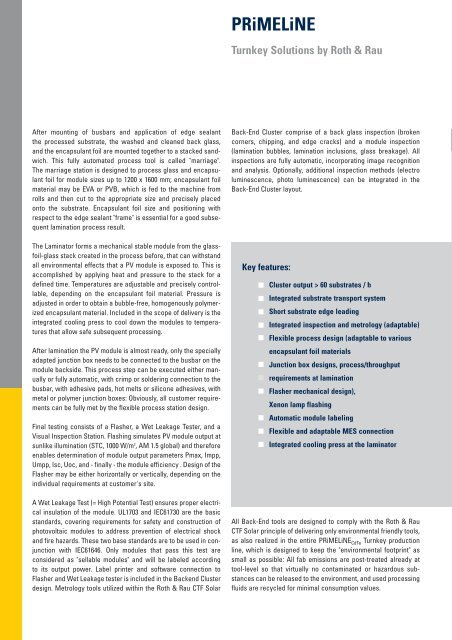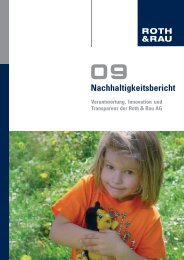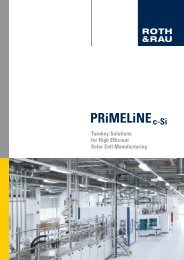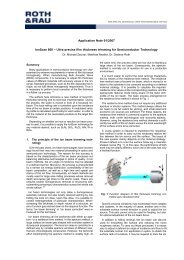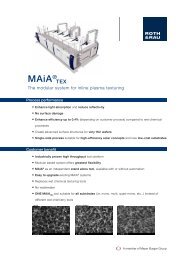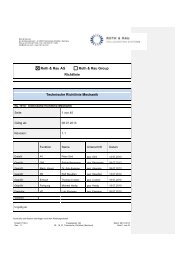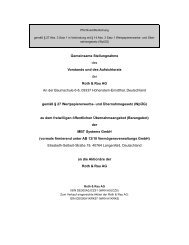PRiMELiNE - Roth & Rau AG
PRiMELiNE - Roth & Rau AG
PRiMELiNE - Roth & Rau AG
You also want an ePaper? Increase the reach of your titles
YUMPU automatically turns print PDFs into web optimized ePapers that Google loves.
<strong>PRiMELiNE</strong><br />
Turnkey Solutions by <strong>Roth</strong> & <strong>Rau</strong><br />
After mounting of busbars and application of edge sealant<br />
the processed substrate, the washed and cleaned back glass,<br />
and the encapsulant foil are mounted together to a stacked sandwich.<br />
This fully automated process tool is called "marriage".<br />
The marriage station is designed to process glass and encapsulant<br />
foil for module sizes up to 1200 x 1600 mm; encapsulant foil<br />
material may be EVA or PVB, which is fed to the machine from<br />
rolls and then cut to the appropriate size and precisely placed<br />
onto the substrate. Encapsulant foil size and positioning with<br />
respect to the edge sealant "frame" is essential for a good subsequent<br />
lamination process result.<br />
The Laminator forms a mechanical stable module from the glassfoil-glass<br />
stack created in the process before, that can withstand<br />
all environmental effects that a PV module is exposed to. This is<br />
accomplished by applying heat and pressure to the stack for a<br />
defined time. Temperatures are adjustable and precisely controllable,<br />
depending on the encapsulant foil material. Pressure is<br />
adjusted in order to obtain a bubble-free, homogenously polymerized<br />
encapsulant material. Included in the scope of delivery is the<br />
integrated cooling press to cool down the modules to temperatures<br />
that allow safe subsequent processing.<br />
After lamination the PV module is almost ready, only the specially<br />
adapted junction box needs to be connected to the busbar on the<br />
module backside. This process step can be executed either manually<br />
or fully automatic, with crimp or soldering connection to the<br />
busbar, with adhesive pads, hot melts or silicone adhesives, with<br />
metal or polymer junction boxes: Obviously, all customer requirements<br />
can be fully met by the flexible process station design.<br />
Final testing consists of a Flasher, a Wet Leakage Tester, and a<br />
Visual Inspection Station. Flashing simulates PV module output at<br />
sunlike illumination (STC, 1000 W/m 2 , AM 1.5 global) and therefore<br />
enables determination of module output parameters Pmax, Impp,<br />
Umpp, Isc, Uoc, and - finally - the module efficiency . Design of the<br />
Flasher may be either horizontally or vertically, depending on the<br />
individual requirements at customer's site.<br />
A Wet Leakage Test (= High Potential Test) ensures proper electrical<br />
insulation of the module. UL1703 and IEC61730 are the basic<br />
standards, covering requirements for safety and construction of<br />
photovoltaic modules to address prevention of electrical shock<br />
and fire hazards. These two base standards are to be used in conjunction<br />
with IEC61646. Only modules that pass this test are<br />
considered as "sellable modules" and will be labeled according<br />
to its output power. Label printer and software connection to<br />
Flasher and Wet Leakage tester is included in the Backend Cluster<br />
design. Metrology tools utilized within the <strong>Roth</strong> & <strong>Rau</strong> CTF Solar<br />
Back-End Cluster comprise of a back glass inspection (broken<br />
corners, chipping, and edge cracks) and a module inspection<br />
(lamination bubbles, lamination inclusions, glass breakage). All<br />
inspections are fully automatic, incorporating image recognition<br />
and analysis. Optionally, additional inspection methods (electro<br />
luminescence, photo luminescence) can be integrated in the<br />
Back-End Cluster layout.<br />
Key features:<br />
Cluster output > 60 substrates / h<br />
Integrated substrate transport system<br />
Short substrate edge leading<br />
Integrated inspection and metrology (adaptable)<br />
Flexible process design (adaptable to various<br />
encapsulant foil materials<br />
Junction box designs, process/throughput<br />
requirements at lamination<br />
Flasher mechanical design),<br />
Xenon lamp flashing<br />
Automatic module labeling<br />
Flexible and adaptable MES connection<br />
Integrated cooling press at the laminator<br />
All Back-End tools are designed to comply with the <strong>Roth</strong> & <strong>Rau</strong><br />
CTF Solar principle of delivering only environmental friendly tools,<br />
as also realized in the entire <strong>PRiMELiNE</strong> CdTe Turnkey production<br />
line, which is designed to keep the "environmental footprint" as<br />
small as possible: All fab emissions are post-treated already at<br />
tool-level so that virtually no contaminated or hazardous substances<br />
can be released to the environment, and used processing<br />
fluids are recycled for minimal consumption values.


